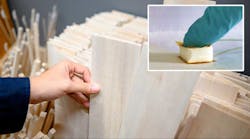Energy harvesting often appears as an attractive “something for (almost) nothing” proposition. Using wood for harvesting seems like an especially virtuous undertaking, as wood is available, ubiquitous, easy to work with, and “natural.”
However, its harvestable output based on the well-known piezoelectric effect (which isn’t just for highly crystalline materials) is low and inadequate for most situations. Piezoelectricity in wood is induced by the displacement of crystalline cellulose in response to applied mechanical stress, resulting in the generation of electrical charges. However, using wood as an energy transducer has been a challenge to its low piezoelectric moduli and the limited deformability of wood itself, resulting in an inefficient conversion.
Further, transforming the natural wood into an improved crystal-like material requires a hazardous chemical process to remove much of the lignin, the stabilizing substance that connects the cells and prevents the rigid cellulose fibrils from compression or buckling (which also helps give wood its strength).
Without special treatment, though, wood isn’t flexible enough. Therefore, when subjected to mechanical stress, any deformation results in only a small amount of voltage and useful current. To transform wood into a material that can easily be deformed, lignin must at least partially be extracted by immersing the wood in a chemical mixture.
Addressing this issue, a research collaboration between Empa (The Swiss Federal Laboratories for Materials Science and Technology) and ETH Zürich (a public research university focused on science, technology, engineering, and mathematics) devised an approach to modifying balsa wood using a natural fungus. They claim that by enhancing the elastic compressibility of balsa wood through this “green” and sustainable fungal decay pretreatment, the wood’s piezoelectric output is increased over 55 times compared to its natural state.
This white rot fungus “ate” through the wood fibers with the balsa wood strongly decayed after 10 weeks, showing a weight loss of 45% and most of the cell walls destroyed, thus forming large spaces between the rays (Fig. 1). This structural alteration is responsible for the high mechanical compressibility of fungal treated wood. Excessive degradation with weight losses (50%, 55%, and 60%) results in a loss of the original shape of the balsa-wood blocks, even without being compressed.
They determined the optimum weight loss of wood to be approximately 45%, as it allows retaining the shape of the wood but improved compressibility. A single cube (15 × 15 × 13.2 mm) of decayed wood produced a maximum voltage of 0.87 V and a current of 13.3 nA under 45-kPa stress (one pascal = one Newton/meter2) (Fig. 2).
The basic graphs for electrical and mechanical performance provide much more insight into the performance (Figs. 3 and 4, respectively).
In previous research, chemical approaches involving reagents such as sodium chlorite, sodium hydroxide, or acetic acid/hydrogen peroxide have been used to remove lignin and hemicellulose from wood. Such methods are faster and more efficient than the use of white rot fungi and could result in more compressible wood structures. However, the researchers note that the merits of these chemical approaches for removing the lignin are outweighed by the sustainable and environment-friendly aspects of the fungi-based method.
Of course, one must keep in mind several cautions: balsa wood is costly, soft, among the least-dense woods, and usually reserved for special projects such as model airplanes and crafts. It doesn’t wear well and removing the lignin will undoubtedly affect its durability and long-term wear characteristics as well as structural strength. Any “dream” of using it for flooring and then harvesting any resulting piezoelectric output due to dancing on it or even walking on it may be just that, in reality.
(If you’re interested in a quantitative, highly detailed enumeration of the many mechanical properties of balsa wood and dozens of other wood species, see “Mechanical Properties of Wood” from the Forest Products Laboratory of the U.S. Department of Agriculture Forest Service.)
The team’s work is described in detail in their paper “Enhanced mechanical energy conversion with selectively decayed wood,” published in AAAS Science Advances, along with scanning electron microscope (SEM) photos of the before/after wood structure. There’s also extensive Supplementary Information.




